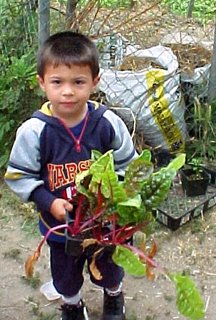The first thing that occurred to me was the benefit of teamwork. The piece that
 Clare Abreu and I produced together was far better than we could have done individually. It was astonishing to think how much the story changed focus in the course of reporting, as well. We started with a story about front-yard residential gardens, until we found out that our “expert” has only produced two such gardens. Then, we turned our attention to the loss of the South Central Farm in Los Angeles and the activism surrounding it. But were these stories worth telling? When we visited the Stanford Avalon Community Garden, Clare and I realized our story had to be on South Central’s outgrowths. This was yet to be explored by the media in any depth.
Clare Abreu and I produced together was far better than we could have done individually. It was astonishing to think how much the story changed focus in the course of reporting, as well. We started with a story about front-yard residential gardens, until we found out that our “expert” has only produced two such gardens. Then, we turned our attention to the loss of the South Central Farm in Los Angeles and the activism surrounding it. But were these stories worth telling? When we visited the Stanford Avalon Community Garden, Clare and I realized our story had to be on South Central’s outgrowths. This was yet to be explored by the media in any depth.At Stanford Avalon in Watts, I was reminded of why I love reporting. The Mexican and Central American immigrant farmers led us into their world. They insisted that we share in their barbeque of carne asada, rice and beans, cactus, salsa and tangy berry juice (even prodding us to go for seconds). Few non-farmers visit them—they were honored to have us. The farmers welcomed us because of trust, too. They saw we were ready to listen and would present them fairly. This mutual respect was crucial. Without their help, there could be no story (or at least not a compelling one).
Clare and I were able to interview some major public figures, which was both gratifying and nerve wracking. (I was so intimidated by Edward James Olmos, best known for his role as the teacher in “Stand and Deliver,” that I forgot to turn on the recorder until half way through the interview. We also interviewed Los Angeles Mayor Antonio Villaraigosa at the garden for 30 seconds before he hopped back in his black sports utility vehicle). The most powerful interviews, however, were done with the common farmers at SA and Proyecto Jardin, a small communal garden (without plots). The farmers were laboring for far more than food. I had no idea that their seeds were a connection to ancestors, passed down for generations. And they swore by their medicinal plants, which were grown beneath power lines.
As beginning journalists, we still deal with people’s lives and livelihoods. This deserves great respect and responsibility. We visit communities that most of us wouldn’t have the time or access to explore otherwise. It’s a cliché, but we’re life-long students of the world.
-David Kates
You can hear David and Clare's story at atnpr.org/about/nextgen/internedition/fall06/showworkingdocokay